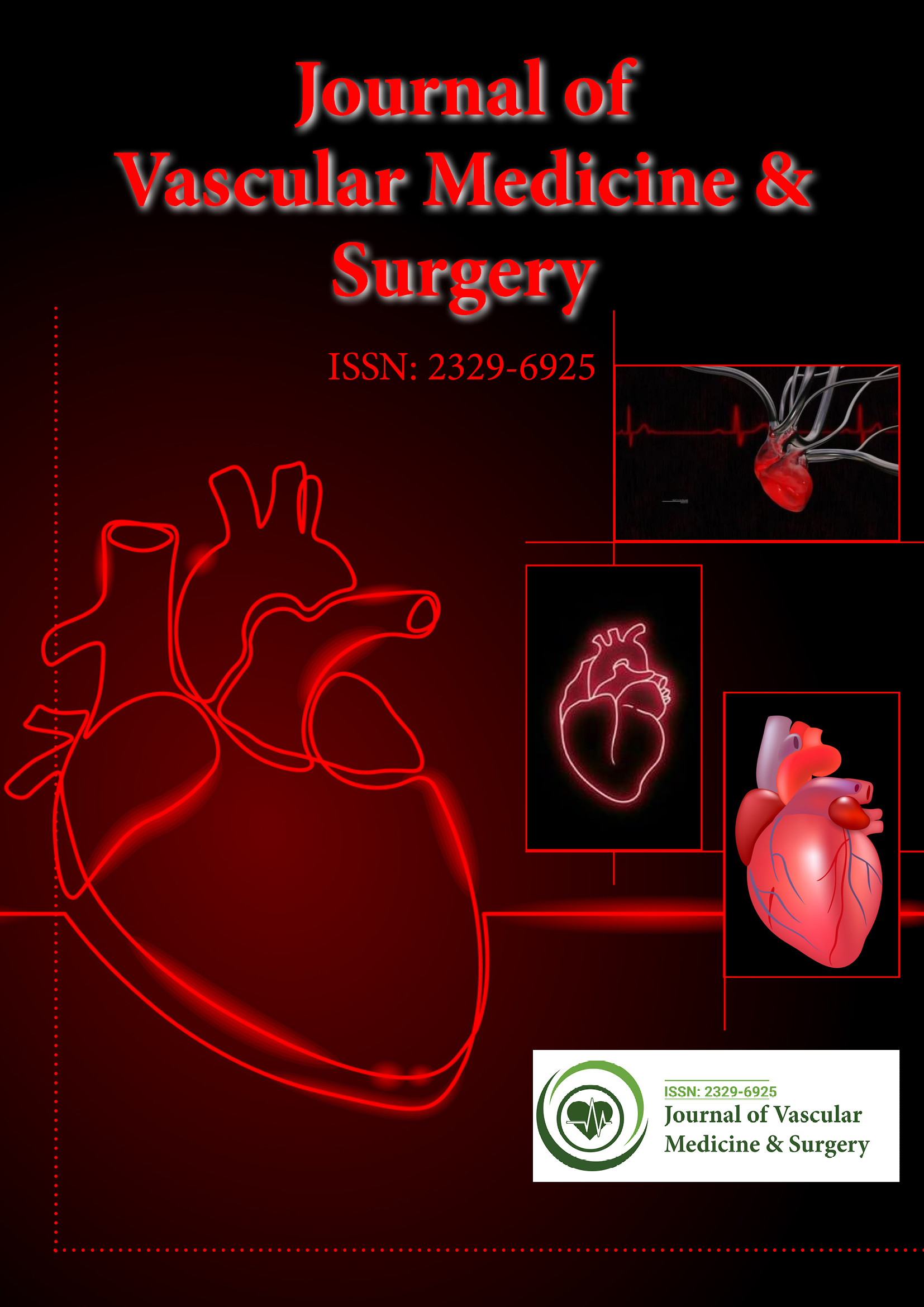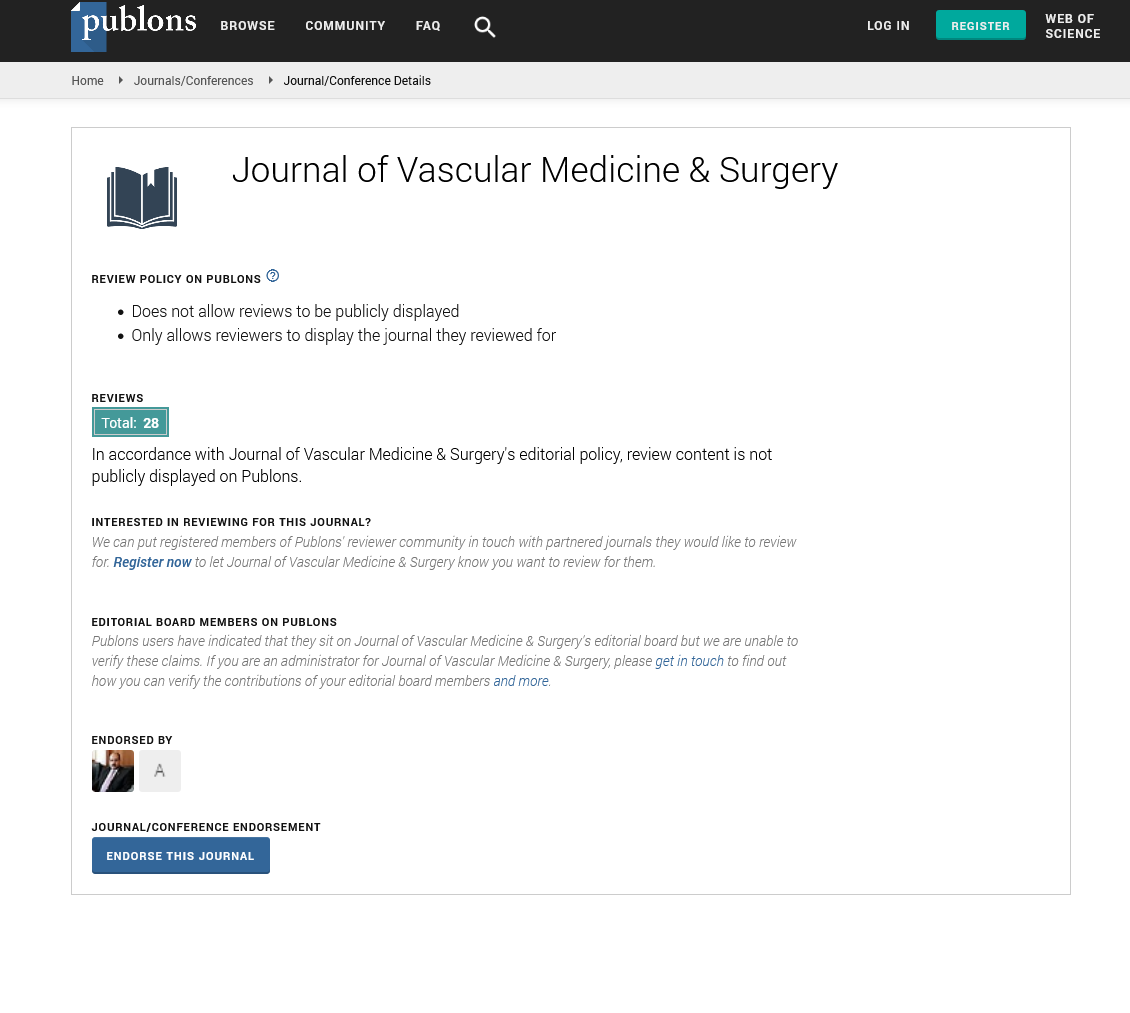Indexed In
- Open J Gate
- Academic Keys
- RefSeek
- Hamdard University
- EBSCO A-Z
- OCLC- WorldCat
- Publons
- Euro Pub
- Google Scholar
- SHERPA ROMEO
Useful Links
Share This Page
Journal Flyer

Open Access Journals
- Agri and Aquaculture
- Biochemistry
- Bioinformatics & Systems Biology
- Business & Management
- Chemistry
- Clinical Sciences
- Engineering
- Food & Nutrition
- General Science
- Genetics & Molecular Biology
- Immunology & Microbiology
- Medical Sciences
- Neuroscience & Psychology
- Nursing & Health Care
- Pharmaceutical Sciences
Short Communication - (2024) Volume 0, Issue 0
The Significant Role of Arteries in the Human Circulatory System
Scott Conrad*Received: 25-Sep-2024, Manuscript No. JVMS-24-27618; Editor assigned: 27-Sep-2024, Pre QC No. JVMS-24-27618 (PQ); Reviewed: 11-Oct-2024, QC No. JVMS-24-27618; Revised: 18-Oct-2024, Manuscript No. JVMS-24-27618 (R); Published: 28-Oct-2024, DOI: 10.35248/2329-6925.24.S24.555
Description
Peripheral Arteries are one of the most essential components of the human circulatory system. These dynamic blood arteries transmit blood with high levels of oxygen from the heart to other regions of the body. Arteries are muscular blood vessels that play an important role in maintaining appropriate blood flow during severe stress. Structurally, arteries consist of three primary layers, each contributing to their functionality and durability.
Structure of arteries
The tunica intima or innermost layer is made up of a thin layer of endothelial cells. These cells provide a smooth outer layer that reduces friction as blood flows through the artery. The integrity of this layer is essential for preventing blood clot formation and maintaining vascular health. The middle layer, the tunica media, is consisting of smooth muscle cells and elastic tissue. This layer allows arteries to maintain their shape and regulate blood pressure by contracting and relaxing in response to signals from the nervous system. The outermost layer, the tunica externa, consists of connective tissue that protects and anchors the artery. This layer also contains small blood vessels, known as the vasa vasorum, which nourish the artery walls themselves. The specific composition of these layers allows arteries both flexible and strong, enabling them to handle the significant pressures generated by the circulatory process of the heart [1-4].
Types of arteries
Arteries can be categorized into three main types based on their size, location and function.
Elastic arteries also known as conducting arteries, these are the largest arteries in the human body, including the aorta and pulmonary arteries. Elastic arteries have an excessive amount of elastic fibers, which enable their ability to expand and relax after every beat of the heart. This flexibility reduces the continuous condition of blood flow, providing regular supply to subsequent arteries.
Muscular arteries also referred to as peripheral arteries, muscular arteries deliver blood to specific organs and tissues. Examples are the kidney and cardiovascular arteries. These arteries have a thicker tunica media with a higher proportion of smooth muscle, enabling precise regulation of blood flow is necessary for the energy requirements of various organs. Arterioles are the smallest type of artery, arterioles lead directly into capillary beds. These vessels play a significant role in controlling blood flow and pressure by adjusting their diameter in response to local and systemic signals [5,6].
Fundamental arteries of the human body
Several major arteries are essential to sustaining life. The below mentioned arteries are some of the most important.
Aorta: The aorta or blood vessel is the main artery in the human circulatory system. It originates from the left ventricle of the heart and branches out to supply oxygenated blood to every organ [7].
Carotid arteries: Located in the neck, the carotid arteries supply blood to the brain, face and neck. Their effective functioning is essential for maintaining sufficient brain circulation.
Coronary arteries: Coronary arteries circulate blood to the cardiovascular muscle. Blockages in the coronary arteries are a common cause of heart attacks.
Femoral arteries: Found in the thigh, the femoral arteries deliver blood to the lower limbs. They are among the largest arteries in the body.
Pulmonary arteries: These arteries are significant because they transmit deoxygenated blood from the heart to the lungs for regeneration, compared to other arteries that transmit oxygenated blood [8].
Functions of arteries
The fundamental role of arteries is to transport oxygenated blood to tissues all over the body. This is accomplished through a wide range of mechanisms.
Oxygen and nutrient delivery: Arteries ensure that oxygen and essential nutrients reach all cells, enabling cellular metabolism and energy production.
Thermoregulation: By controlling blood flow to the skin, arteries help to regulate body temperature. Increased blood flow to the skin absorbs heat, while decrease circulation helps to preserves temperature [9,10].
References
- Podrid PJ, Fogel RI, Fuchs TT. Ventricular arrhythmia in congestive heart failure. Am J Cardiol. 1992;69(18):82-96.
[Crossref] [Google Scholar] [PubMed]
- Kuo CS, Munakata K, Reddy CP, Surawicz B. Characteristics and possible mechanism of ventricular arrhythmia dependent on the dispersion of action potential durations. Circ. 1983;67(6):1356-1367.
[Crossref] [Google Scholar] [PubMed]
- Lampert R, Joska T, Burg MM, Batsford WP, McPherson CA, Jain D. Emotional and physical precipitants of ventricular arrhythmia. Circ. 2002;106(14):1800-1805.
[Crossref] [Google Scholar] [PubMed]
- Hennessy S, Leonard CE, Newcomb C, Kimmel SE, Bilker WB. Cisapride and ventricular arrhythmia. Br J Clin Pharmacol. 2008;66(3):375-385.
[Crossref] [Google Scholar] [PubMed]
- McLenachan JM, Henderson E, Morris KI, Dargie HJ. Ventricular arrhythmias in patients with hypertensive left ventricular hypertrophy. N Engl J Med. 1987;317(13):787-792.
[Crossref] [Google Scholar] [PubMed]
- Podrid PJ, Fuchs T, Candinas R. Role of the sympathetic nervous system in the genesis of ventricular arrhythmia. Circ. 1990;82(2Suppl):I103-I113.
[Google Scholar] [PubMed]
- Cao JM, Fishbein MC, Han JB, Lai WW, Lai AC, Wu TJ, et al. Relationship between regional cardiac hyperinnervation and ventricular arrhythmia. Circ. 2000;101(16):1960-1969.
[Crossref] [Google Scholar] [PubMed]
- St John Sutton M, Lee D, Rouleau JL, Goldman S, Plappert T, Braunwald E, et al. Left ventricular remodeling and ventricular arrhythmias after myocardial infarction. Circ. 2003;107(20):2577-2582.
[Crossref] [Google Scholar] [PubMed]
- Dresen WF, Ferguson JD. Ventricular arrhythmias. Cardiology clinics. 2018;36(1):129-139.
- John RM, Tedrow UB, Koplan BA, Albert CM, Epstein LM, Sweeney MO, et al. Ventricular arrhythmias and sudden cardiac death. Lancet. 2012;380(9852):1520-1529.
Citation: Conrad S (2024). The Significant Role of Arteries in the Human Circulatory System. J Vasc Surg. S24:555.
Copyright: © 2024 Conrad S. This is an open access article distributed under the terms of the Creative Commons Attribution License, which permits unrestricted use, distribution and reproduction in any medium, provided the original author and source are credited.

